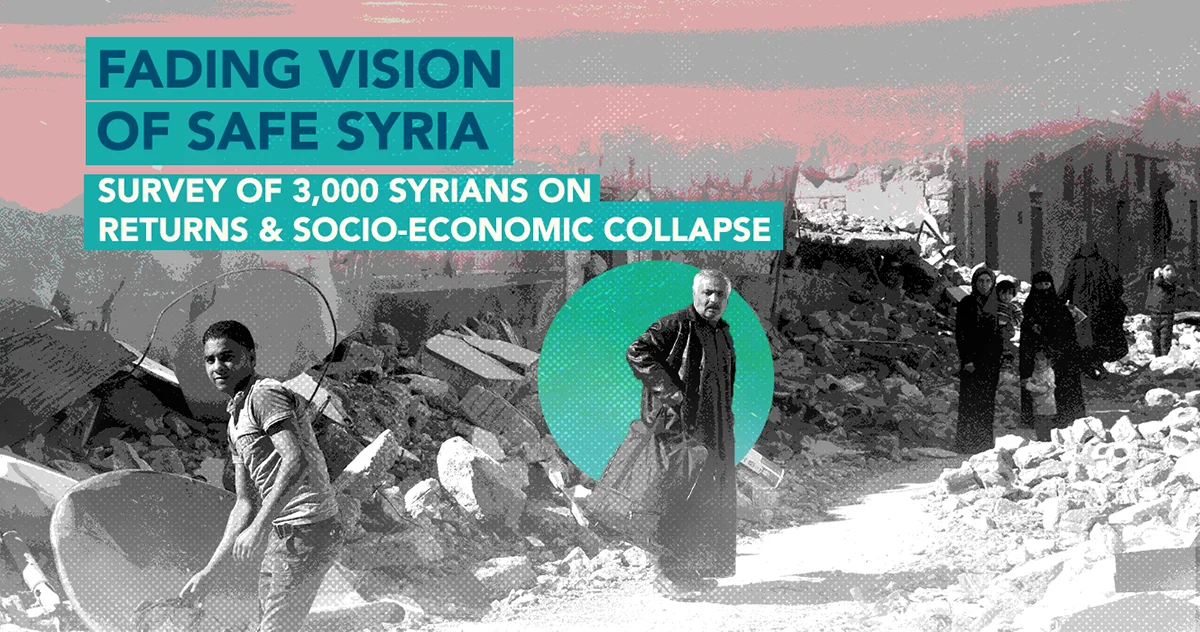SACD’s comprehensive report, “Fading Vision of a Safe Syria” provides an in-depth analysis of the current conditions and urgent needs of displaced Syrians. This report is based on 3,007 structured interviews across regime-controlled areas and AANES/SDF-controlled areas. The sample included diverse segments of Syrian society, ensuring representativeness in terms of gender, age, displacement profile, and socio-economic background.
Executive summary
More than half of Syria’s pre-war population are still living in situations of displacement inside or outside the country, with approximately 5.5 million refugees displaced outside Syria’s borders—mostly in Lebanon, Türkiye, Egypt, Iraq and Jordan—and another 7.2 million Syrians internally displaced inside the country.
As new international crises emerge and global attention and core humanitarian funding shifts elsewhere, some policymakers and observers are tempted to understand Syria as a post-conflict context simply because we do not hear about it as much anymore. The conflict is in a quasi-frozen state with the Syrian regime expending immense efforts in recent years, including through Syria’s 2022 universal periodic review (UPR) at the UN,[1] to portray itself as victor following 13 years of conflict, and Syria therefore as a “post-conflict” context in which the serious work of rebuilding, transitional justice and reconciliation can now begin.[2]
Even if regime-held areas may superficially appear to be in their own post-conflict phase, the regime’s behaviour has not changed, even in the face of continued pressure and regional overtures towards partial normalization. The regjme deftly utilized the devastating February 2023 Syrian-Turkish earthquake in pursuit of normalization with the international community and regional states, but that normalization has failed, in part, due to the regime’s inability—and unwillingness—to provide a safe environment for Syrians and neighboring countries alike. It is because of this complete lack of positive behavioral change by the regime that no significant returns have taken place in Syria in recent years.
With interest in the Syrian conflict waning following Russia’s invasion of Ukraine in February 2023 and Israel’s horrific attack on the Gaza Strip still unfolding (at the time of writing), it has never been more important to provide substantiated, well-informed material to guide policymaking around Syria and the Syrian conflict.
As such, the SACD conducted a far-reaching survey amongst refugee/IDP, resident and returnee populations in regime-controlled areas of the country and AANES/SDF-controlled areas of north-east Syria to obtain a detailed understanding of how Syrians inside Syria feel about the issues affecting their lives—the economy and socio-economic deprivation, service provision and governance, security policies, detention and human rights, return, and the prospects for a political solution in Syria that can bring an end to the conflict, address root causes and provide a safe and dignified environment for the return of refugees and IDPs in the future.
The resulting SACD survey was therefore specifically designed to represent the views and experiences of as wide as possible a sample of Syrians. Compared with the SACD’s last survey, which reached some 1,100 Syrians inside and outside the country, the survey you are reading is based on interviews with more than 3,000 Syrians—including refugees, IDPs as well as those who were never forced to flee their homes after 2011.
The respondents’ answers highlight how damaging the current status quo has become. Syrians are poorer than ever and also more pessimistic about the future. Most of those surveyed who live in the regime-held areas have come to see the Syrian regime as a critical barrier to any form of positive change in the country, and that changes to the socio-economic, humanitarian and political situation in Syria cannot happen with the current political formation in place. Many have little faith in the UN-led political process but appear divided on what alternative future solutions might look like. With Syria displaying many of the signs of a failed state, more needs to be done to listen to the opinions of Syrians living face-to-face with the realities of the conflict.
And while Syria’s crippling economic downturn is a key concern to the surveyed Syrians—with many in regime areas considering ways to leave the country as and when they get the opportunity to do so—security is still the priority when it comes to ways to end the conflict and create the appropriate environment for returns.
In that sense, the demands and views of Syrians inside and outside the country has changed little since the very beginning of the uprising and conflict.
Selected key findings
- Safety and security: A significant 75% of Syrians in regime-controlled areas and over half in northeast Syria do not feel safe, facing threats such as arbitrary arrests, forced conscription, and conflict-related violence.
- Economic hardship: 90% of Syrians in regime areas live below the poverty line, with 72% dependent on humanitarian aid.
- Barriers to return: Only 1.1% of refugees expressed an intention to return to Syria within the next year, citing safety and economic conditions as major deterrents.
- Detention remains a defining fact of life for Syrians in regime areas: Despite regime fanfare about amnesty decrees, just 17 percent of respondents said that previously detained relatives were released through a recent decree—from November 2023—with more than three-quarters of surveyed respondents doubting the seriousness and meaningfulness of the amnesty as a result.
- Socio-economic deprivation is having an increasingly prominent impact on Syrians’ futures. More than half of residents of regime areas and north-east Syria say they are dissatisfied with economic conditions in their respective places of residence; three-quarters of the Syrians in regime areas who said they were thinking of emigrating if and when they get the opportunity to do so said that economic factors were behind their thinking.
- Almost all of those who returned would not advise others to follow in their footsteps. Some 85 percent of returnees in regime areas and 91 percent in north-east Syria said they would not recommend that other displaced Syrians do the same.
- Possibly more displacements to come, not less. SACD’s findings suggest that Syria is now seeing growing emigration and displacement intentions among populations within regime areas who were never displaced during the conflict but are now being forced into considering a life outside Syria because of the country’s economic collapse.
- Disappearing vision of the future of Syria. Less than a quarter of respondents expressed any optimism whatsoever towards the UN-led political process, with many distrustful of the actors involved or the entire process itself.
Conclusions
The report highlights that the root causes of Syria’s conflict remain unaddressed, with the regime’s oppressive security apparatus still in place. Syrians are demanding significant political reforms and security sector changes before considering a return home. Syrians in all areas of the country are poorer than ever before, but it would be a mistake to believe that by addressing poverty and economic indicators, the millions of refugees and IDPs displaced from their homes would suddenly consider going back.
One thing that is abundantly clear from the survey findings is that, without systemic changes to the regime and its security apparatus as well as socio-economic conditions inside the country, refugees and IDPs will not return to the country in any significant way—on the contrary, more Syrians will leave. Once a bedrock of UN Resolution 2254, security sector reform is one of the most important future solutions in Syria for refugees and IDPs—as well as those Syrians who have never fled their homes but live with the insecurity, corruption and monopolisation that typifies life in regime-held Syria.
Despite its grandstanding about transitional justice, prisoner amnesties and the rest, the lack of any demonstrable and meaningful behaviour change by the regime, coupled with refugees’ and IDPs’ unwillingness to return home for the foreseeable future, means that the situation may reach a point of critical mass in the future whereby more Syrians are leaving the country—whether fleeing violence and persecution, instability, or poverty—than those returning. Stories from Libya of new generations of Syrian refugees, too young to remember the worst days of the conflict, boarding “death boats” in the Mediterranean points to the myriad risks that Syrians are willing to expose themselves and their families in search of a better life.
Read the full report with detailed findings here:
[1] Syrian Legal Development Programme (SLDP) & We Exist, Fallacies not Facts: A critical legal study of the national report submitted by the Syrian Arab Republic in the third cycle of the universal periodic review in 2022,< https://weexist-sy.org/wp-content/uploads/Fallacies-not-Facts_EN.pdf> accessed 10 April 2024.
[2] Veronica Bellintani, ‘The Assad Regime’s Post-Conflict Narrative in the International Arena’, Tahrir Institute for Near East Policy (TIMEP), 10 May 2022, <https://timep.org/2022/05/10/the-assad-regimes-post-conflict-narrative-in-the-international-arena/> accessed 27 March 2024.



